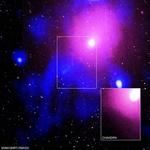Other

“An international team led by astronomers from the Curtin University node of the International Centre for Radio Astronomy Research (ICRAR) has discovered a new type of stellar object that challenges our understanding of the physics of neutron stars. The object …

“A team mapping radio waves in the Universe has discovered something unusual that releases a giant burst of energy three times an hour, and it’s unlike anything astronomers have seen before. The team who discovered it think it could …

“Scientists from the International Centre for Radio Astronomy Research (ICRAR) and The University of Western Australia (UWA) have set a world record for the most stable transmission of a laser signal through the atmosphere. In a study published today in …

“Scientists studying a distant galaxy cluster have discovered the biggest explosion seen in the Universe since the Big Bang. The blast came from a supermassive black hole at the centre of a galaxy hundreds of millions of light-years away. It …

